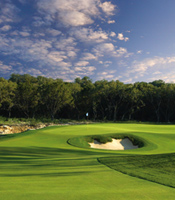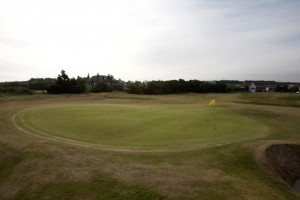How to Get Close to Pins
A few years ago, I forget which tournament it was, Tiger Woods had to return for a Monday morning sudden death playoff as the previous night it had got too dark to finish play. The first hole of the playoff was a par three, with the pin tucked against the left side of the green. Tiger all-but holed his tee shot to win the tournament. It looked like the perfect stroke of genius you expect (or at least expected then) of the man. But then, in a very candid admission to reporters afterwards, he admitted that he had pulled every shot on the range, so had aimed away from the pin to the largest part of the green, knowing a perfect shot was safe and the pull he’d been hitting on the range would take him towards the flag. There – simple, honest and one of the most lucrative miss-hits in history.
 So, why do so many amateurs tend to club and aim based on their very best possible shot? Tiger isn’t alone; you’ll often hear tour pros say in a post-round interview how they were aiming at the “fat half of the green”. This basically means that if the hole is cut on the left hand side of the green, they were aiming to the right of it, and vice versa. Its fundamental course management that we should all embrace, as it optimises your chances of scoring well.
So, why do so many amateurs tend to club and aim based on their very best possible shot? Tiger isn’t alone; you’ll often hear tour pros say in a post-round interview how they were aiming at the “fat half of the green”. This basically means that if the hole is cut on the left hand side of the green, they were aiming to the right of it, and vice versa. Its fundamental course management that we should all embrace, as it optimises your chances of scoring well.
But what most golfers tend to overlook is that this simple rule has another dimension to it. Standing in the middle of a fairway, or on the tee of a par three, most amateur golfers’ routines involve working out a yardage to the flag (e.g. 150yards), choosing a club to hit the ball that far (e.g. 7 iron), taking dead aim and then pulling the trigger. How many people go through the process of thinking about the most sensible place to put the ball on the green? Who actually thinks about where they want to be putting from or the “best miss”? Confused?
Well, it all boils down to percentages and to considering distance as well as direction when deciding where to attempt to leave the ball. Let’s pretend you’ve got 150 yards to a flag at the front of a raised green, with deep bunkers on either side. For argument’s sake, your best struck 7 iron reaches 150 yards. Anything other than a 100% strike is ending up short of the green and rolling away from the flag, leaving you with a difficult chip. Anything slightly off line will be buried in a deep bunker. A perfect 7 iron may be the club if the Gods are smiling but it’s a pretty low percentage shot. What’s more, get it wrong and you’re bringing double bogey into play. So what about playing your 6 iron? With the 6 iron, a 100% strike will take you past the pin, perhaps to the back of the green, leaving you with 20 foot putt back for birdie. But a slightly off centre strike will still have enough to get you on the front of the green, and possibly closer to the hole. Hit it left or right, and you might well clear the front bunkers to leave an easier up’n’down.
On another hole, you might find a different scenario with the pin at the back of the green. Let’s say you’ve got 180 yards to the flag. A good four iron might be the perfect club for this distance, but knock it the slightest bit too far, and you’re over the back and into bushes. The prudent play would be to hit the 5 iron that maxes out at 175yards. It might not seem like much club, but would you rather be putting from 5 yards away, or playing a lob shot from 4 yards, from a bush with not much green to work with?
 What both of these examples show is that the key to getting your yardages correct is to think about where you want the ball to finish, not where you want it to land. If you’re between clubs e.g. a pitching-wedge and 9 iron, you might want to hit the 9 as well struck it may grip and spin back towards the flag despite landing beyond it. Hit the pitching wedge and you’ll be spinning away from the hole. Equally with a long shot, allow for some run up the green. You may wish to use this advice to make sure you steer clear of a weakness – if you’re uncomfortable in bunkers, you can choose a club that you know will go past the greenside bunker but still leave a putt. If the green is on two tiers, concentrate on picking the club most likely to finish on the correct tier.
What both of these examples show is that the key to getting your yardages correct is to think about where you want the ball to finish, not where you want it to land. If you’re between clubs e.g. a pitching-wedge and 9 iron, you might want to hit the 9 as well struck it may grip and spin back towards the flag despite landing beyond it. Hit the pitching wedge and you’ll be spinning away from the hole. Equally with a long shot, allow for some run up the green. You may wish to use this advice to make sure you steer clear of a weakness – if you’re uncomfortable in bunkers, you can choose a club that you know will go past the greenside bunker but still leave a putt. If the green is on two tiers, concentrate on picking the club most likely to finish on the correct tier.
Admittedly, just taking yardage into account is naive. Other factors will of course have an influence on your shot choice, such as wind, elevation, and ground conditions, as you’ll no doubt witness throughout the season. There are multiple factors to consider when trying to get close to pins, but for simplicity’s sake start by thinking more about your yardages as a first priority.
The key is to ask yourself how far do you NEED to hit it, rather than how far do you NORMALLY hit it. After all, unless you’re trying to hole every iron shot you hit, you should always focus on giving yourself the best chance of doing so with your next shot. That’s how to avoid a hefty score. Start getting this right and you’ll be armed with the tools to hit to the fat part of the green every time. The pins will seem closer and closer!